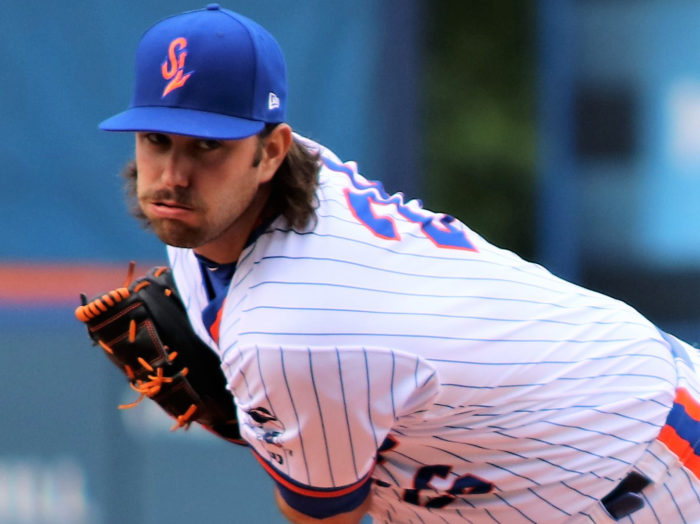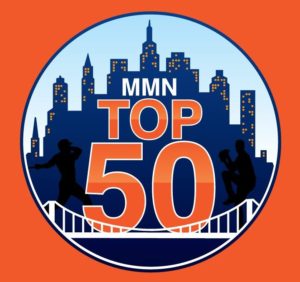
Position: SP B/T: L/L Age: September 3, 1995 (23)
Acquired: First round (20th) of 2017 Amateur Draft from U. Oregon
2018 Stats (High & Low-A): 22 GS, 553 BF (25.1 BF/G), 3.16 ERA, 2.77 FIP, 1.17 WHIP, 8.09 K/9, 2.11 BB/9
The concept of positional depth is perhaps the most important component of a team’s overall strength. With injuries as prevalent as they are in today’s game, a front line is nothing without qualified players ready to step in at any time. Mets’ Assistant General Manager, Systematic Development Adam Guttridge has written extensively on the subject in the past, and it is no doubt at the forefront of the philosophy that he brings to the front office.
Saying that the Mets have struggled with their depth in recent seasons isn’t some sort of a revolutionary statement. This is a team, after all, that gave 12 starts to Corey Oswalt in 2018, over 55 innings to Hansel Robles in 2017, and over 1,000 plate appearances to Jose Reyes from 2016-2018.
The team made it a goal to address their depth concerns this offseason. They’ve seemingly succeeded on the offensive side and they’ll tell you they made strides in backing up their rotation. The reality, however, is that going into 2019 with Oswalt, Walker Lockett, Kyle Dowdy, Hector Santiago, Chris Flexen, and Drew Gagnon as reinforcements is a big bet on their ability to produce at a moment’s notice.
I promise we’ll get to the point of this piece in a moment, but remember that the Mets traded their top upper-minors starting pitcher, Justin Dunn, to the Seattle Mariners earlier in the offseason. While Dunn certainly carries volatility of his own, the organization is now seriously lacking in upside pitching prospects that could realistically see the major leagues sooner rather than later.

David Peterson/Photo by Ed Delany, MMN
That brings us to David Peterson, the Mets’ first-round draft pick in 2017. With the departure of Dunn, Peterson is now the closest to the major leagues among the system’s pitching prospects — perhaps worrisome considering he finished 2018 in High-A.
The left-hander did not sign and report to Brooklyn until midway through July 2017, so by the time he completed the mandatory throwing program for recent draftees, it was not until August 4 that he was able to make his professional debut. An ingrown toenail ultimately limited him to three starts for the Cyclones. None of them lasted more than 1.2 innings, and thus his career really didn’t begin until 2018.
Even then, he remained in Port St. Lucie at the end of Spring Training to nurse a minor knee injury. He made his season debut with the Columbia Fireflies on April 18 and needed just nine starts at the level before moving up to High-A. Before he left, Peterson broke off a gem of an outing, working eight innings of one-run ball, striking out ten and walking none.
Overall, his trip to Columbia was nothing short of dominant, and to be fair, it probably wasn’t a level he should have been at in the first place. The Mets have notoriously been conservative with placements for recent draftees, so while fellow 2017 first-rounders Kyle Wright, J.B. Bukauskas, and Alex Faedo — who all, like Peterson, came out of powerhouse college programs — reached Double-A in 2018 (Wright even worked six major league innings for the Braves), Peterson simply ended with a half-season in High-A. Pitching development, obviously, isn’t linear, but it’s an interesting point of comparison.
Still, it’s better to dominate a level than not, and Peterson was up to the task. With the Fireflies, he struck out over five times as many batters as he walked and, among pitchers who threw as many innings as he did, recorded the South Atlantic League’s third-lowest FIP.
The adjustment to St. Lucie, however, did not go swimmingly. The immediate returns were ugly: through his first nine starts, as many as he had made in Columbia, Peterson had put up a 6.50 ERA, .342 BAA, and his strikeout rate was down ten points from where it was with the Fireflies.
But, as all good players do, Peterson rebounded. Although it came in a smaller sample size of four starts, Peterson ended the year on the highest of notes, allowing no earned runs while holding hitters to a .103/.146/.103 line. He struck out an outstanding 31.7 percent of his batters faced. His ability to make adjustments and finish the year strong is, from a player development perspective, his biggest accomplishment thus far as a professional.
At the outset of the hot streak, Peterson credited his improving changeup with turning things around. Ultimately, it’ll be his development of the pitch that will determine his major league value. His fastball sits around 90 mph, which isn’t much by today’s standards, but he commands it well and uses his large frame to work downhill effectively. His best secondary offering is his slider, which he can locate in the zone and use as an out-pitch. If Peterson can develop that change into another viable pitch to keep hitters guessing, he’ll have three plus weapons to attack hitters with. The floor is pretty solidly entrenched in the back of a major league rotation, which, given his high draft selection, isn’t blow-you-away upside, but it’s a lot better than many players boast.
In their evaluation, Eric Longenhagen and Kiley McDaniel of Fangraphs summarized that Peterson could “save the Mets some money on that No. 3 or 4 starter that so many teams overpay for in free agency.” It’s a great point that is often overlooked when discussing pitching development, where a common perception is that players either project as front-of-the-rotation aces or they’re relegated to the bullpen. Producing efficient pitchers to fill out the rotation is equally as important, and in turn, bolsters a team’s depth.
Peterson doesn’t have the raw stuff to average more than seven or eight strikeouts per nine innings in the major leagues, so the Mets will have to bank on him limiting walks (he has) and doing the little things. Luckily, he does them very well.
First, he keeps the ball on the ground. In 2018, only two qualified pitchers (one being fellow Met Scott Copeland) in all of the minor leagues induced a higher rate of ground balls than Peterson’s 64.5 percent. In Columbia, he received about league-average results on those plays, but in St. Lucie, his BAA on the ground was over 20 points worse than the rest of the league. Given that just under half of his ground ball hits went to infielders, it can be inferred that better defenders behind him (a rarity in the minors) would yield even better outcomes (I tried to find some examples of said plays, but MiLB.TV has removed their archives in preparation for the upcoming season). Removing defense from the equation, his 2.77 FIP was the best among Mets minor leaguers (min. 100 IP) by nearly 50 points.
Peterson doesn’t allow fly balls very often (second-lowest rate in the organization, behind Copeland), but when he does, they stay in the ballpark. Peterson has faced 549 batters as a professional and allowed just two home runs, good for an outstanding 2.6 HR/FB rate. Just an aberration? Unlikely, as in college he posted equally as great numbers: eight home runs allowed to 1,077 batters faced in three seasons.
When a pitcher performs well in A-ball, the opinions quickly turn to “let’s see if he can do it in Double-A.” There’s every reason to believe that Peterson will avoid the proverbial brick wall that many pitchers reach when they hit the upper levels. He goes about his craft cerebrally, brings a fantastic presence to the mound, and if he’s able to put everything together, will be able to serve a useful role on a major league staff. The only conceivable impediment is his lack of present and future velocity in the rotation.
The Mets don’t need to rush his progression through the system — his performance will do that for him — but a strong spring (in both major and minor league camp) could push him to Binghamton to open the season. The more likely path is waiting until the weather in the Northeast warms up before booking him a flight from Florida to the Southern Tier.
Given the departure of Dunn and the uncertainties surrounding the organization’s other pitching prospects (#TINSTAAPP), Peterson’s development in 2019 will say a lot about the state of the Mets’ pitching staff for years to come.
Editor’s Note: Jarred Kelenic, Justin Dunn, Luis Santana, Ross Adolph, Bobby Wahl, Adam Hill, Gerson Bautista, and Felix Valerio were all in our original Top 50 before they were traded.
Previous Rankings
50-46 Led by Michael Paez
45-41 Led by Ranfy Adon
40-36 Led by Anthony Dirocie
35-31 Led by Ryley Gilliam
30-26 Led by Chris Viall
25 Carlos Cortes
24 Ali Sanchez
23 Eric Hanhold
22 Luis Carpio
21 Freddy Valdez
20 Walker Lockett
19 Junior Santos
18 Gavin Cecchini
17 Jordan Humphreys
16 Christian James
15 Tony Dibrell
14 Francisco Alvarez
13 Will Toffey
12 Adrian Hernandez
11 Desmond Lindsay
10 Franklyn Kilome
9 Shervyen Newton
8 Thomas Szapucki

6 Anthony Kay
